Santa Clara is home to a variety of birds, including both migratory and resident species. From the colorful and vibrant hummingbirds to the majestic Golden Eagles, Santa Clara’s bird population is both diverse and abundant.
From the coastal wetlands to the rolling hills of the Bay Area, the birds of Santa Clara provide a beautiful backdrop to the region’s natural landscape. From the great blue heron to the western meadowlark, these birds are a reminder of the importance of conserving our natural habitats and protecting our feathered friends.
1. Anna’s Hummingbird
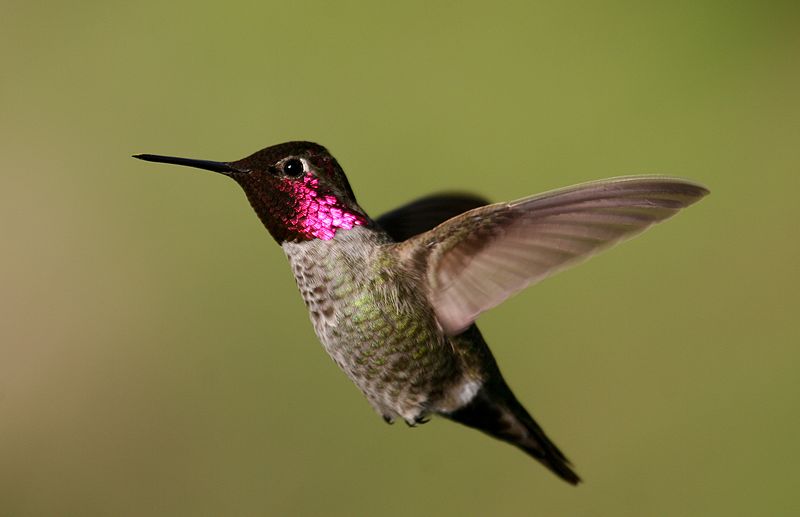
Anna’s hummingbird is a beautiful species of bird belonging to the Trochilidae family. Native to western coastal regions of North America, it was named after Anna Masséna, Duchess of Rivoli.
In the early 20th century, these birds bred only in northern Baja California and southern California but due to ornamental plant transplanting they can now be found across much of Pacific Coast region.
They are medium-sized with bright emerald green feathers on their back and crowns as well as rose-red patches at the throat for males which makes them quite distinguishable from other birds.
Their diet consists mainly nectar from flowers although they will occasionally feed on insects or spiders too making them important pollinators that help maintain healthy ecosystems.Scientific classification:
| Kingdom | Animalia |
| Phylum | Chordata |
| Class | Aves |
| Order | Apodiformes |
| Family | Trochilidae |
| Genus | Calypte |
| Species | C. anna |
2. California Scrub Jay
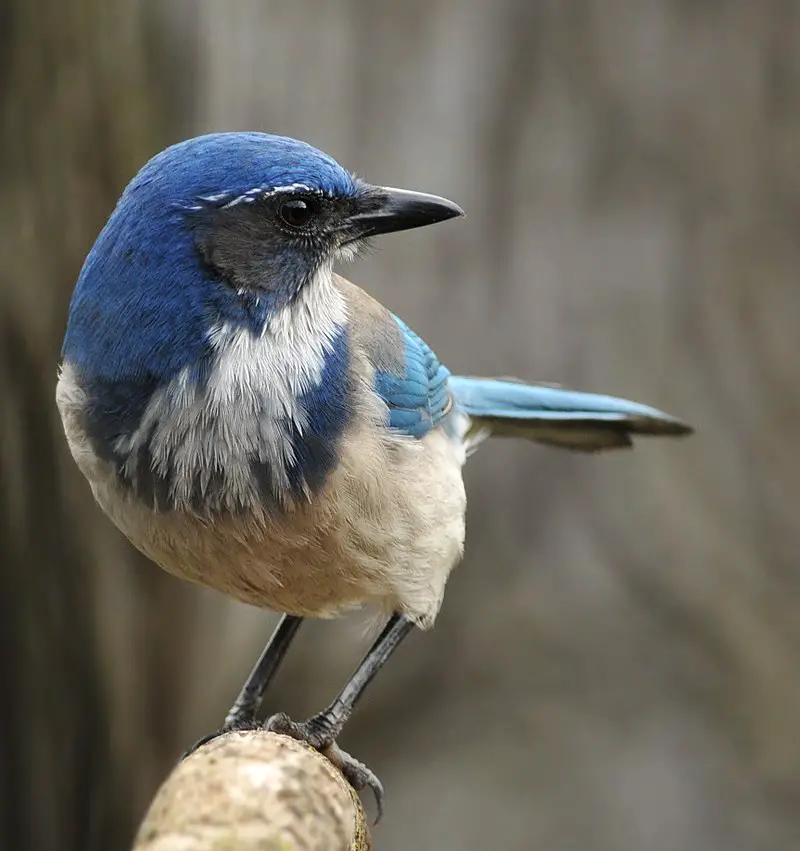
The California scrub jay is a species of bird native to western North America. It can be found from southern British Columbia all the way down through California and western Nevada near Reno, up to west beyond the Sierra Nevada range.
This beautiful blue feathered bird was once categorized with Woodhouse’s scrub jay as the “western scrub jay” along with island scrub jays.
The California Scrub Jay has distinctive features such as its greyish-blue feathers on its head, wings and tail; white cheeks; dark bill; and strong legs for perching in trees which makes it stand out among other birds in its family.Scientific classification:
| Kingdom | Animalia |
| Phylum | Chordata |
| Class | Aves |
| Order | Passeriformes |
| Family | Corvidae |
| Genus | Aphelocoma |
| Species | A. californica |
3. Western Bluebird
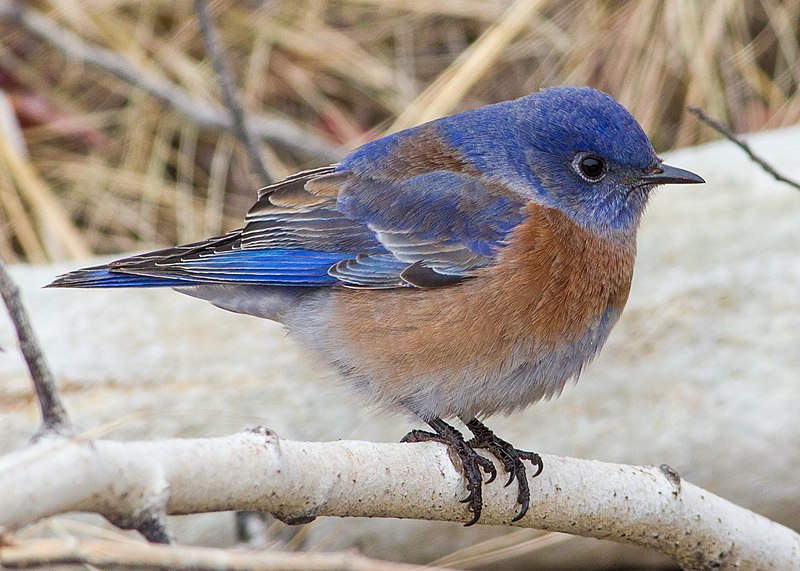
The Western Bluebird is a small North American thrush that was formally described by English naturalist William John Swainson in 1832.
It has six subspecies and measures 15 to 18 cm long, with the adult male being bright blue on top and light orange-brown underneath.
Its wings have white bars which contrast against its bright plumage. The female is duller overall but retains the same wing pattern as its counterpart.
In addition, it also sports an attractive reddish patch near its bill area when breeding season arrives.
This species can be found inhabiting open woodlands, grassy meadows or agricultural areas of western America from Alaska southwards into Mexico and Guatemala where they feed mainly on insects such as beetles, flies, ants etc..
All in all this gorgeous bird adds colour to any environment.Scientific classification:
| Kingdom | Animalia |
| Phylum | Chordata |
| Class | Aves |
| Order | Passeriformes |
| Family | Turdidae |
| Genus | Sialia |
| Species | S. mexicana |
4. Lesser Goldfinch
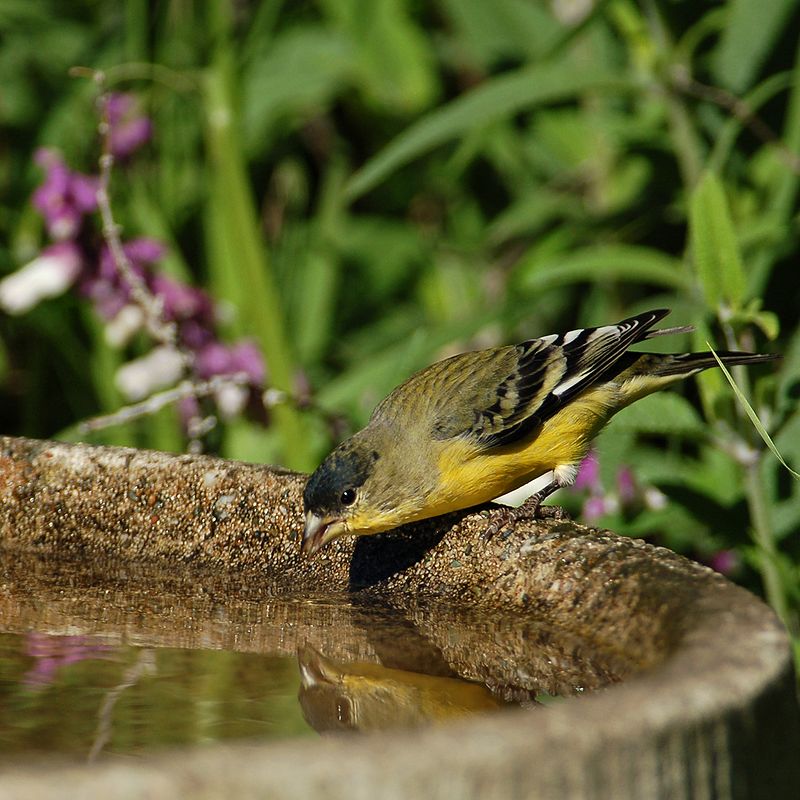
The Lesser Goldfinch is a tiny species of bird found in the Americas. It belongs to the same clade as American goldfinches and Lawrence’s goldfinches, which can be identified by their males having black or rarely green foreheads.
The face appears red or yellow on these birds unlike other species in its genus Spinus sensu stricto.
They are small songbirds with short bills, brown wings and tails with white edges, grey-brown backs and olive heads.
These birds inhabit open woodlands and fields where they feed mainly on seeds from weeds such as thistle, pigweed and ragweed but also consume insects at times during breeding season for additional nutrition.
In addition to being an important part of North America’s avian ecology, these birds have been popularized through recent artwork depicting them in various poses among flowers.Scientific classification:
| Kingdom | Animalia |
| Phylum | Chordata |
| Class | Aves |
| Order | Passeriformes |
| Family | Fringillidae |
| Subfamily | Carduelinae |
| Genus | Spinus |
| Species | S. psaltria |
5. American Bushtit
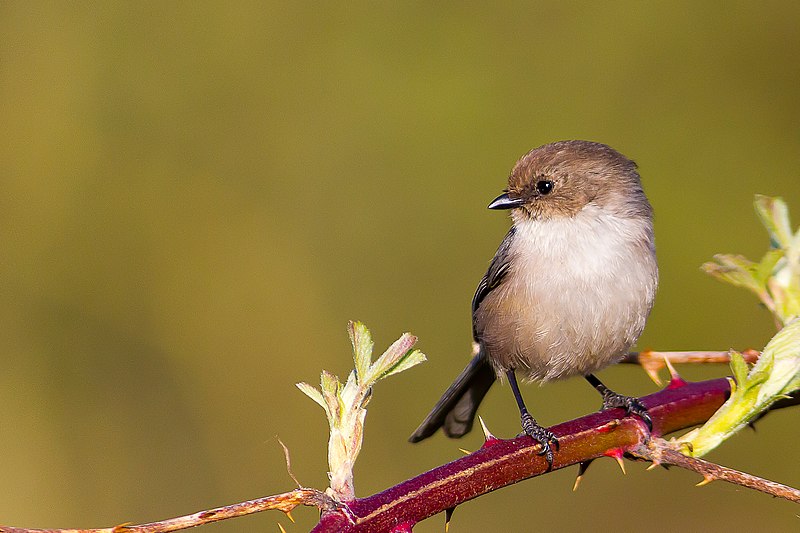
The American bushtit is a small, social bird found in the New World. It’s the only species of its genus and family, Psaltriparus minimus.
First described by John Kirk Townsend in 1837, it inhabits forests and coasts from Alaska to Mexico.
With their tiny size (4-5 inches) they are easily identified by their gray or brown backs with white underparts.
Bushtits have long wings allowing them to travel quickly between trees; they form flocks that move together through branches looking for food such as insects, spiders eggs and fruit while emitting soft chirps or squeaks.
They build beautiful large pendulous nests made of mosses which hang from tree branches high above ground level where they sleep at night.
These charming birds make delightful company during outdoor activities like hiking or camping trips.Scientific classification:
| Kingdom | Animalia |
| Phylum | Chordata |
| Class | Aves |
| Order | Passeriformes |
| Family | Aegithalidae |
| Genus | Psaltriparus Bonaparte, 1850 |
| Species | P. minimus |
6. Chestnut-Backed Chickadee
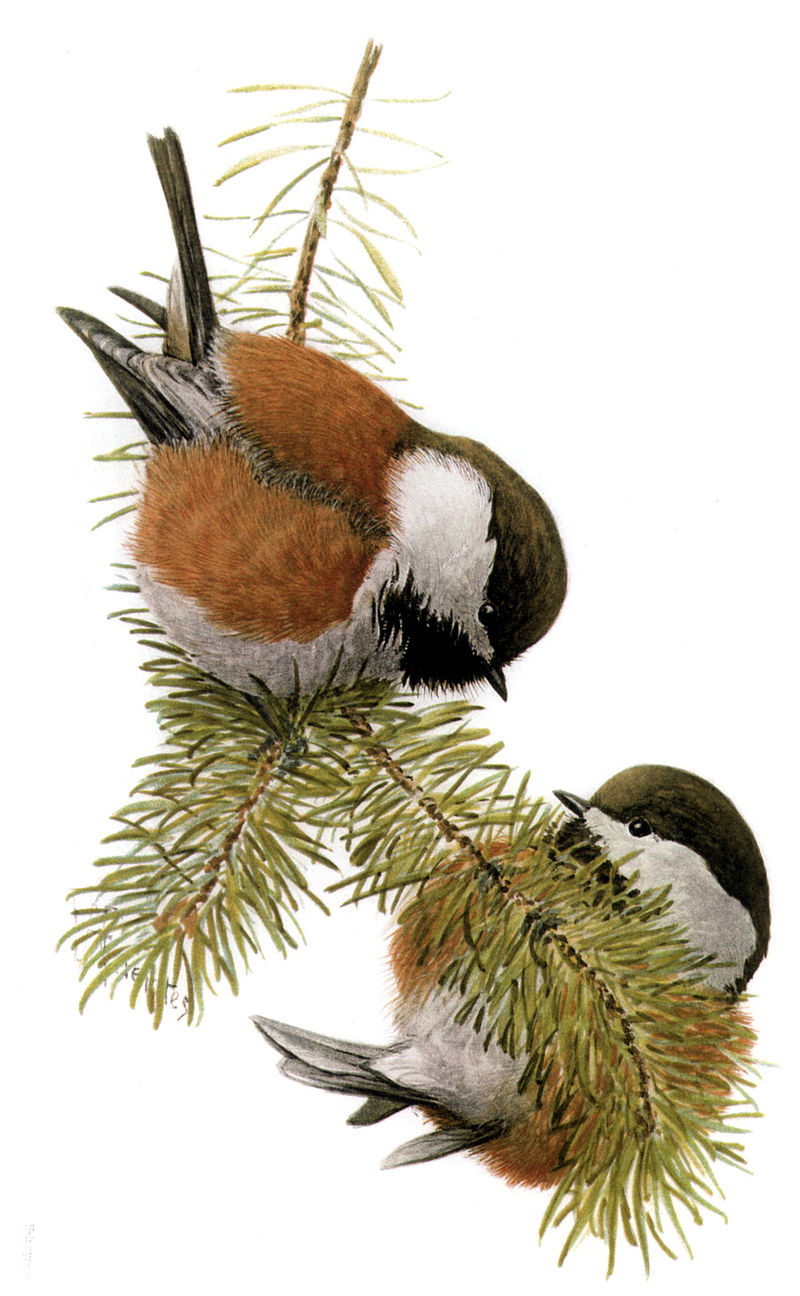
The Chestnut-backed Chickadee is a small passerine bird in the tit family, Paridae. It lives within the Pacific Northwest region of America and Canada; its range extending from southern Alaska to southwestern California.
This species remains a permanent resident throughout its area rather than migrating seasonally, although feeding flocks may temporarily move short distances for food sources.
They are commonly found in woodlands with dense understory vegetation as well as suburban gardens.
The male and female birds can be distinguished by their distinctive patterned plumage: males have brown backs while females are grayer above but both share white bellies and buffy sides striped with black barring across their wings and tails.
These sociable birds usually feed on insects or seeds which they obtain from trees or shrubs using their sharp beaks.Scientific classification:
| Kingdom | Animalia |
| Phylum | Chordata |
| Class | Aves |
| Order | Passeriformes |
| Family | Paridae |
| Genus | Poecile |
| Species | P. rufescens |
7. House Finch

The House Finch is a species of finch native to western North America and has been introduced in the eastern half of the continent as well as Hawaii.
It’s an average-sized finch with adults measuring 12.5 – 15 cm (5 – 6 inches) long and having wingspans between 20 – 25 cm (8 – 10 inches).
The upperparts are brown, while its underparts range from pale grayish white to yellow depending on subspecies.
Its face is streaked or spotted with reddish coloration; males typically have brighter plumage than females due to sexual dimorphism.
They’re mostly found near human habitations such as farms and gardens where they feed on grains, fruits, insects etc., making them very popular among birders who want something colorful for their backyard.Scientific classification:
| Kingdom | Animalia |
| Phylum | Chordata |
| Class | Aves |
| Order | Passeriformes |
| Family | Fringillidae |
| Subfamily | Carduelinae |
| Genus | Haemorhous |
| Species | H. mexicanus |
8. American Crow
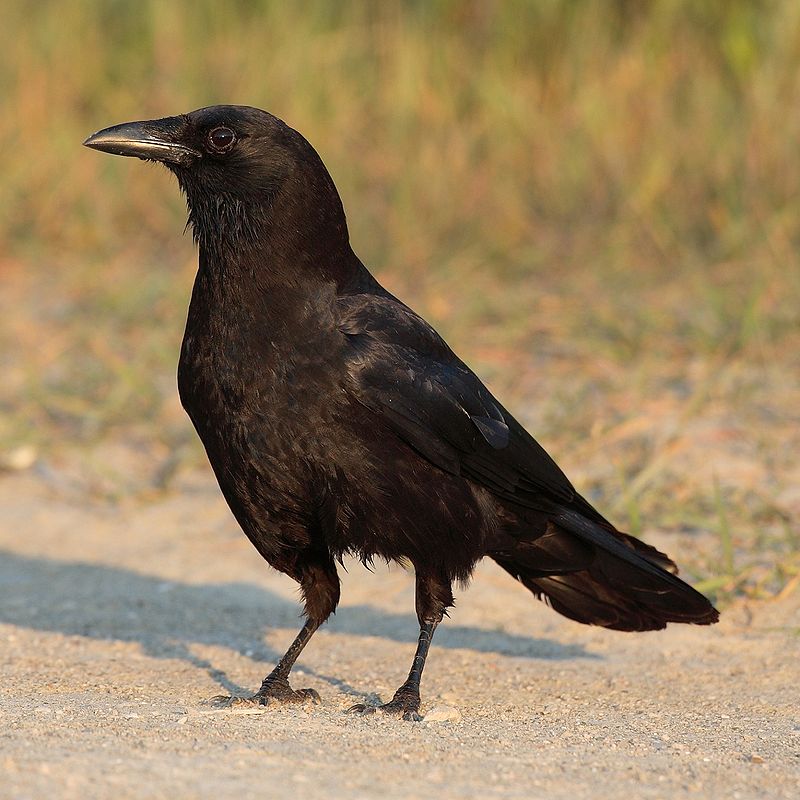
The American crow is a large bird of the Corvidae family, native to most parts of North America.
It is similar in size and structure to its European counterpart, the carrion crow, as well as Eurasia’s hooded crow.
The three species occupy the same ecological niche, but are distinguishable by their differences in appearance.
American crows have black feathers covering their entire body with wingspan averaging between 17-21 inches wide for males and 16-19 inches for females.
They feed on insects such as grasshoppers, beetles and caterpillars; they also eat grains from fields or abandoned farms during winter months when food sources become scarcer.
In addition to feeding habits American crows can be identified by their distinct call which resembles a “caw” sound that travels long distances over open terrain making them popular among birdwatchers.Scientific classification:
| Kingdom | Animalia |
| Phylum | Chordata |
| Class | Aves |
| Order | Passeriformes |
| Family | Corvidae |
| Genus | Corvus |
| Species | C. brachyrhynchos |
9. Mourning Dove
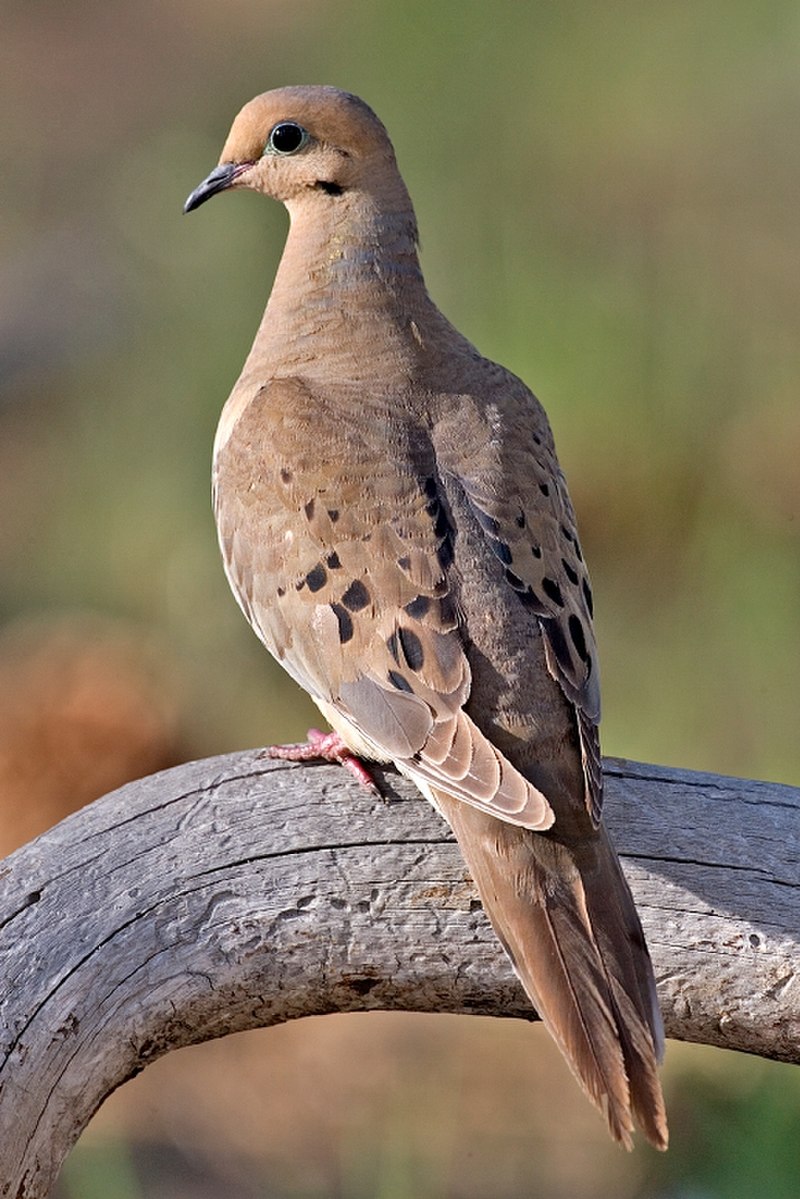
The Mourning Dove is a breathtakingly beautiful bird. It has stunning gray and brown feathers with white tipped wings, giving it an elegant appearance. Its long tail also adds to its graceful look in flight.
A symbol of peace and serenity, they are abundant across North America and can be found in gardens or open fields throughout the year.
As well as being popular game birds for hunters, they feed on grains such as wheat and millet providing important food sources for wildlife species including foxes, coyotes, skunks and raccoons.
These doves have a distinctive cooing sound that can often be heard echoing through woodlands during summer evenings making them one of nature’s greatest treasures.Scientific classification:
| Kingdom | Animalia |
| Phylum | Chordata |
| Class | Aves |
| Order | Columbiformes |
| Family | Columbidae |
| Genus | Zenaida |
| Species | Z. macroura |
10. Brown-Headed Cowbird
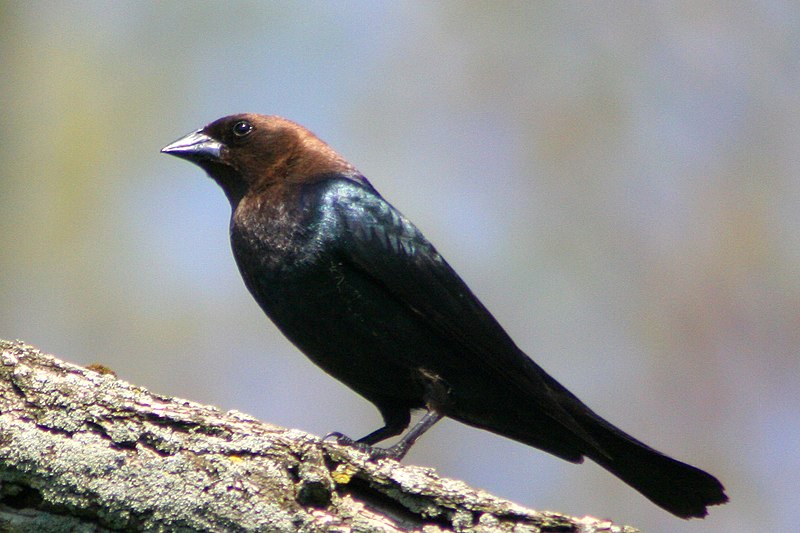
The Brown-headed Cowbird is a small, obligate brood parasitic icterid native to temperate and subtropical North America. It has a brown head with glossy black plumage on the body, wings and tail feathers.
During summer months it can be found in prairies, grasslands as well as open wooded areas but during winter they migrate southwards towards the United States of Mexico for warmer climate.
They are mainly insectivorous birds which feed on insects like caterpillars or beetles but also consume some grains too.
The female bird lays its eggs in nests of other species who then incubates them until hatching time thus leaving their own chicks uncared for by themselves.Scientific classification:
| Kingdom | Animalia |
| Phylum | Chordata |
| Class | Aves |
| Order | Passeriformes |
| Family | Icteridae |
| Genus | Molothrus |
| Species | M. ater |
11. Pine Siskin
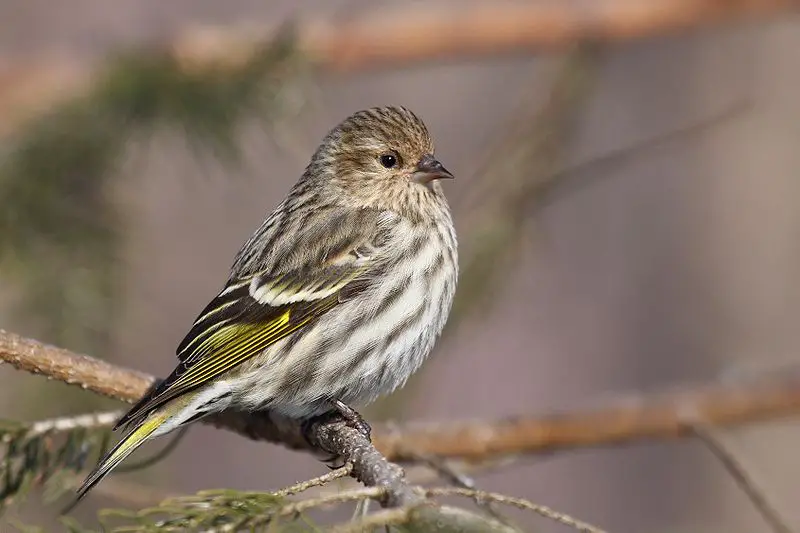
The Pine Siskin is a small bird from the finch family, primarily found in North America. It has an irregular migratory range and was first described by American ornithologist Alexander Wilson in 1810.
The species gets its name pinus, which means “pine-tree” in Latin, due to its frequent presence near coniferous trees.
Pine siskins are known for their yellow wing bars and streaked chests as well as their perky mannerisms when perched on branches or flying around looking for food during colder months.
They feed mostly on seeds of weeds, grasses and other plants but can also be seen consuming insects at times during summertime nesting season.
Its loud calls often alert nearby birds of potential danger while they nest high up among pine tree limbs where predators cannot reach them easily.Scientific classification:
| Kingdom | Animalia |
| Phylum | Chordata |
| Class | Aves |
| Order | Passeriformes |
| Family | Fringillidae |
| Subfamily | Carduelinae |
| Genus | Spinus |
| Species | S. pinus |
12. Oak Titmouse
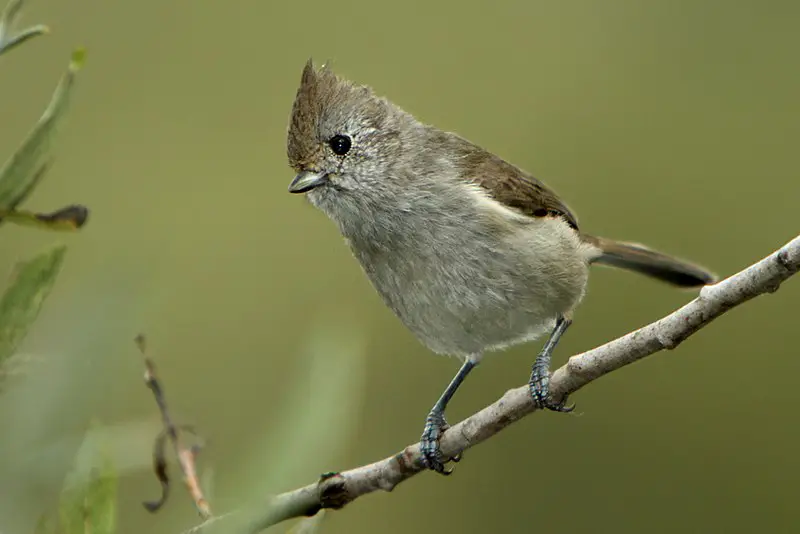
The Oak Titmouse is a small passerine bird of the tit family, Paridae. It has an overall grayish-brown plumage with a cream-colored undersides and its face is plain in coloration lacking any distinct patterning or markings.
The distinguishing feature of this species however, is the tufted crest on top of its head that gives it a unique appearance.
They are native to western North America where they inhabit oak woodlands and chaparral habitats at elevations between sea level up to 5500 feet above sea level.
These birds feed mostly on insects such as caterpillars but also consume seeds and fruits during colder months when insect prey becomes scarce.
In addition, they have been seen stealing food from other birds’ nests including acorn Woodpecker’s caches.Scientific classification:
| Kingdom | Animalia |
| Phylum | Chordata |
| Class | Aves |
| Order | Passeriformes |
| Family | Paridae |
| Genus | Baeolophus |
| Species | B. inornatus |
13. Bewick’s Wren
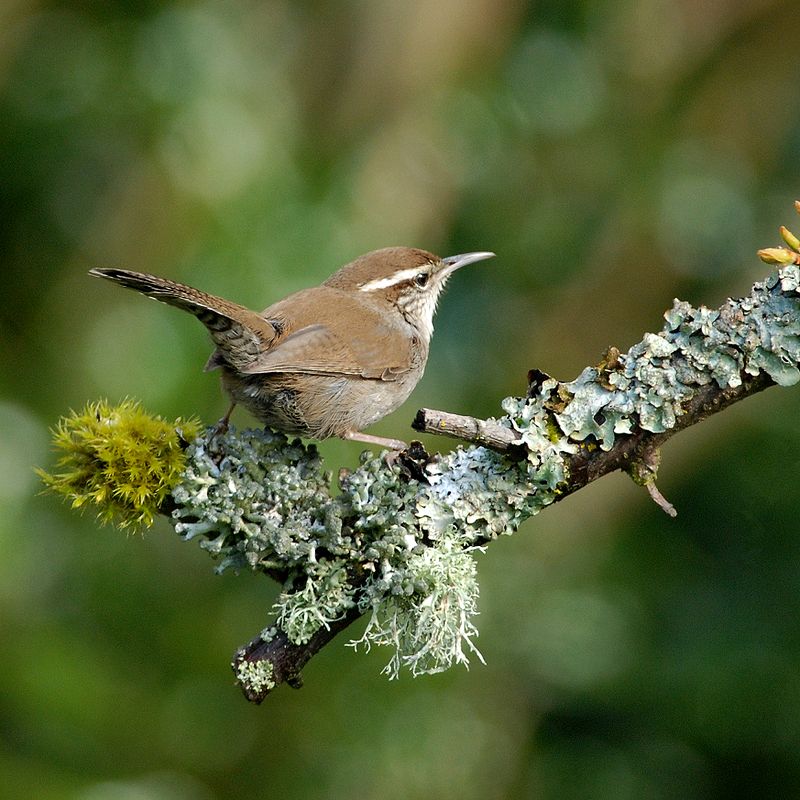
The Bewick’s wren (Thryomanes bewickii) is a small, grey-brown bird native to North America. Measuring at around 14 cm long it has distinctive white markings on its face and tail giving it an attractive appearance.
It can often be found in thickets or scrubby areas as well as urban gardens and parks.
Its song is loud and melodious which makes them popular amongst ornithologists; they are known for their complex vocalisations composed of whistles, clicks, churrs and trills.
The Bewick’s Wren mainly feeds on insects but will also eat fruits if available during the colder months when food may otherwise be scarce.
This species of wren plays an important role in controlling insect populations making them beneficial inhabitants of our environment.Scientific classification:
| Kingdom | Animalia |
| Phylum | Chordata |
| Class | Aves |
| Order | Passeriformes |
| Family | Troglodytidae |
| Genus | Thryomanes P.L. Sclater, 1862 |
| Species | T. bewickii |
14. California Towhee
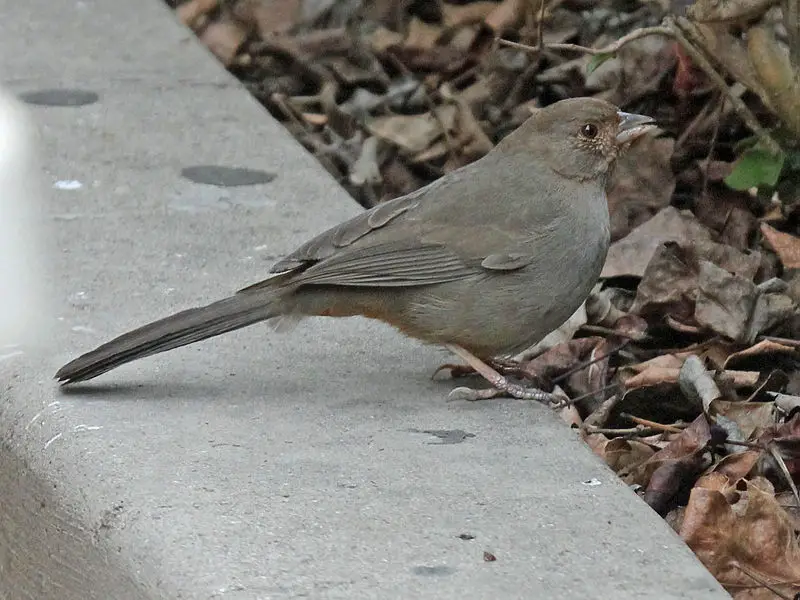
The California towhee (Melozone crissalis) is a medium-sized bird belonging to the family Passerellidae.
It can be found in coastal regions of Oregon, California and Baja California Sur in Mexico.
This species has been subject to taxonomic debate – some authors place it within Fringillidae instead.
The male Californian towhee are easily identified by their greyish brown plumage with black streaks on its back, tail and wings; while females have duller colors than males but still retain the same patterned feathering as them.
Additionally, they possess an orange-colored bill and legs which adds a pop of color to their otherwise dusky appearance.Scientific classification:
| Kingdom | Animalia |
| Phylum | Chordata |
| Class | Aves |
| Order | Passeriformes |
| Family | Passerellidae |
| Genus | Melozone |
| Species | M. crissalis |
15. Black Phoebe
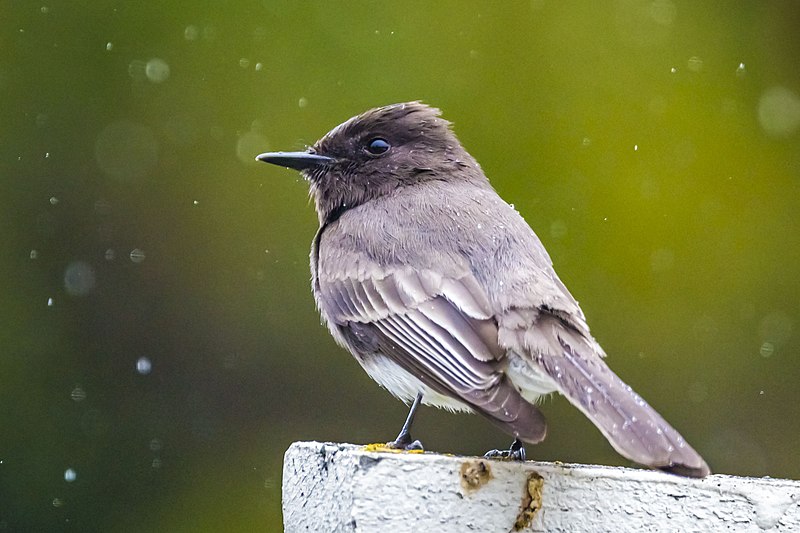
The black phoebe is a beautiful passerine bird belonging to the tyrant-flycatcher family. It breeds from southwest Oregon and California south through Central and South America, where it can be found year-round.
However, its northern populations tend to migrate seasonally in some areas. Six subspecies of this species have been identified so far: two are occasional visitors while the others are more common residents in their range.
The adult has mainly dark grey upperparts with a white belly; juveniles may show brownish tones instead of grey ones on their back.
Its main diet consists of insects which it catches by hovering over water or flying out after them from perches near rivers or streams – hence why they’re often seen around these places.Scientific classification:
| Kingdom | Animalia |
| Phylum | Chordata |
| Class | Aves |
| Order | Passeriformes |
| Family | Tyrannidae |
| Genus | Sayornis |
| Species | S. nigricans |
16. Northern Mockingbird
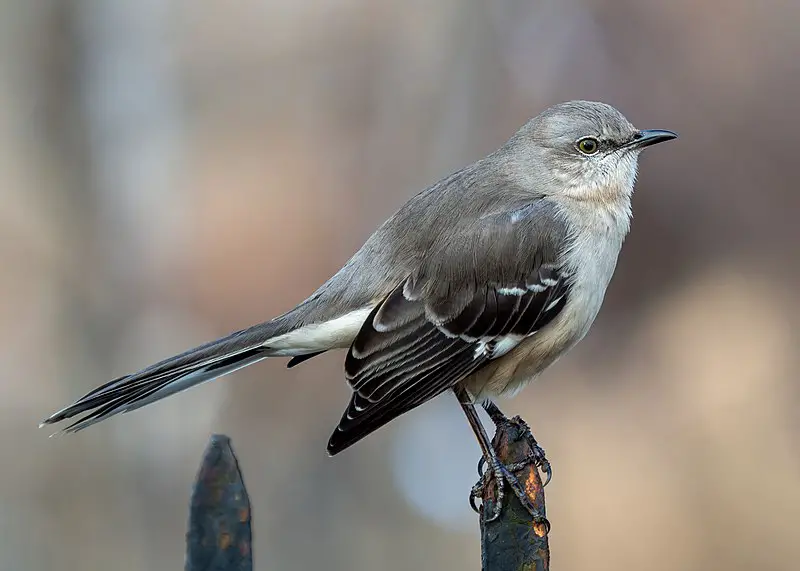
The northern mockingbird is a common fixture in North American skies. It has greyish-brown upperparts and a paler underside with white wing patches, and its distinctive long tail makes it easy to spot.
This adaptable bird can often be seen singing from the tops of trees or fences, though it rarely strays into Europe.
The species was first described by Carl Linnaeus in his 1758 Systema Naturae as Turdus polyglottos – aptly named for their remarkable ability to mimic other birds’ songs.
Northern mockingbirds typically live on insects, fruits, berries and seeds but they will also happily scavenge food scraps left out by humans.
With its beautiful song and striking plumage this beloved avian makes an important contribution to our environment.Scientific classification:
| Kingdom | Animalia |
| Phylum | Chordata |
| Class | Aves |
| Order | Passeriformes |
| Family | Mimidae |
| Genus | Mimus |
| Species | M. polyglottos |
17. Nuttall’s Woodpecker
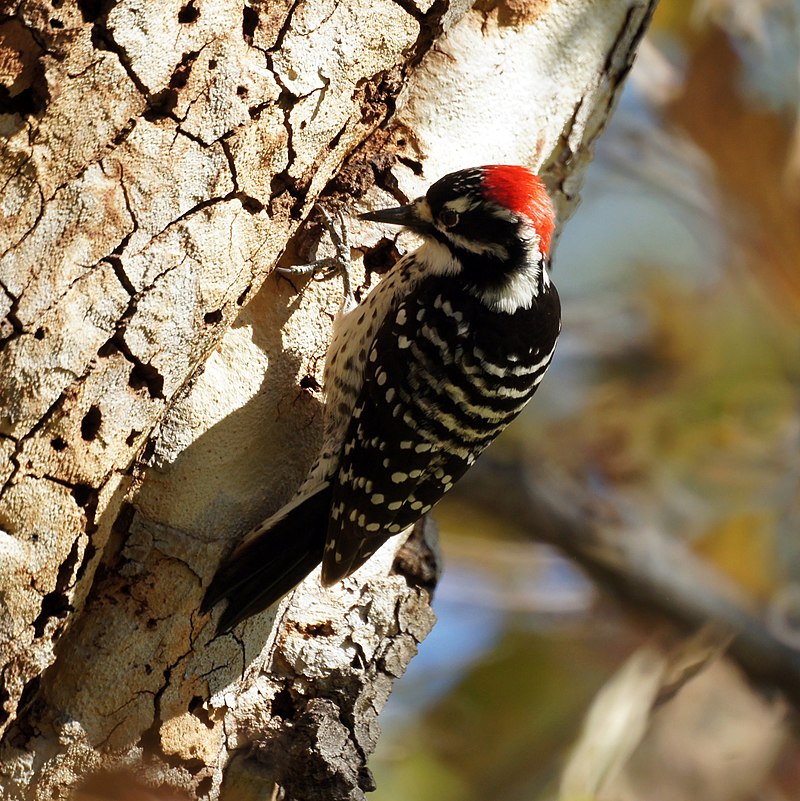
Nuttall’s woodpecker is a species of woodpecker named after naturalist Thomas Nuttall in 1843.
It is found mainly in oak woodlands of California and resembles the ladder-backed woodpecker genetically and physically.
The bird has black wings and tail feathers with white barring, as well as a white ventral surface decorated by small black spots.
They are quite distinct from other species due to their unique colouring; they have been known to hybridize successfully with red-naped sapsuckers when their habitats overlap.
While not considered threatened or endangered, these birds must be monitored closely to ensure that populations remain healthy across their range.Scientific classification:
| Kingdom | Animalia |
| Phylum | Chordata |
| Class | Aves |
| Order | Piciformes |
| Family | Picidae |
| Genus | Dryobates |
| Species | D. nuttallii |
18. Dark-Eyed Junco

The Dark-eyed Junco is a species of small, grayish sparrows that are found across much of temperate North America and in the Arctic during summer.
It was formally described by Carl Linnaeus in 1766, who named it after its distinctive dark eyes.
This bird has a very variable appearance due to the many different subspecies it contains, making its systematics difficult to unravel.
The plumage varies from white or light gray on their underparts with slate grey backs and wings; black heads with white outer tail feathers; brown head stripes; yellow bills; pink legs and feet; as well as various shades between all these colours.
They also have considerable sexual dimorphism where males tend to be more colourful than females but share similar characteristics such as short tails and rounded bodies – both sexes being around 16 cm long when fully grown.Scientific classification:
| Kingdom | Animalia |
| Phylum | Chordata |
| Class | Aves |
| Order | Passeriformes |
| Family | Passerellidae |
| Genus | Junco |
| Species | J. hyemalis |
19. White-Breasted Nuthatch
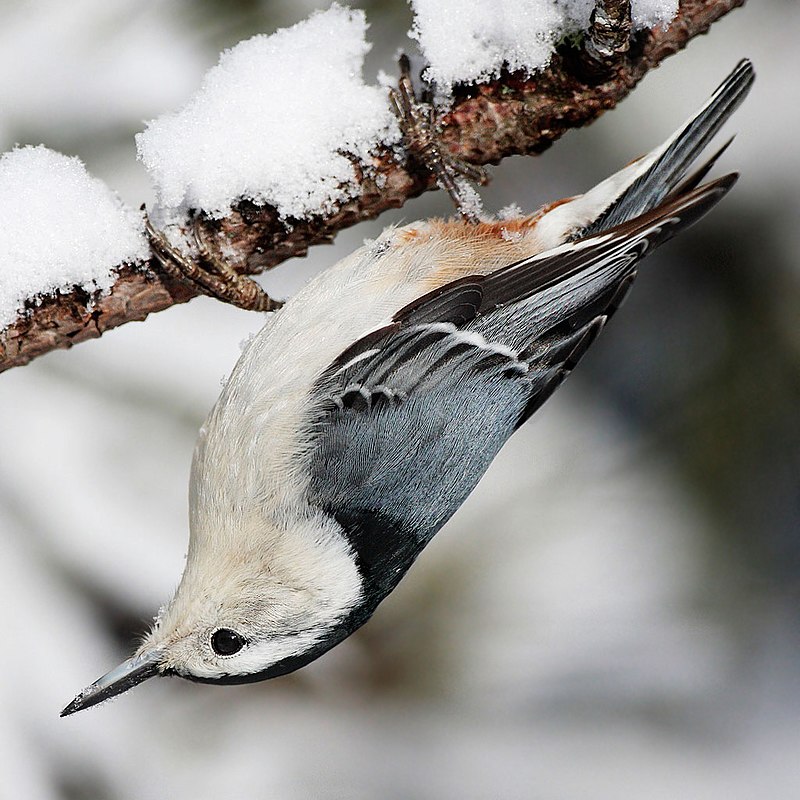
The White-breasted Nuthatch is a medium-sized bird belonging to the nuthatch family Sittidae. It measures around 15.5 cm in length and its colour varies throughout its range.
Males have a light blue-grey upperpart, with black crown and nape whereas females have a dark grey crown instead of black one.
The underparts are whitish, with reddish tinge on sides and flanks while the bill is short and stout with pale base near eyes which can be yellow or white depending upon geographic location..
This species feeds mainly on insects but will also eat seeds, nuts and berries when available.
They prefer open woodlands where they often climb trees searching for food along trunks as well as branches underneath bark crevices creating their nest there too.Scientific classification:
| Kingdom | Animalia |
| Phylum | Chordata |
| Class | Aves |
| Order | Passeriformes |
| Family | Sittidae |
| Genus | Sitta |
| Species | S. carolinensis |
20. Hooded Oriole
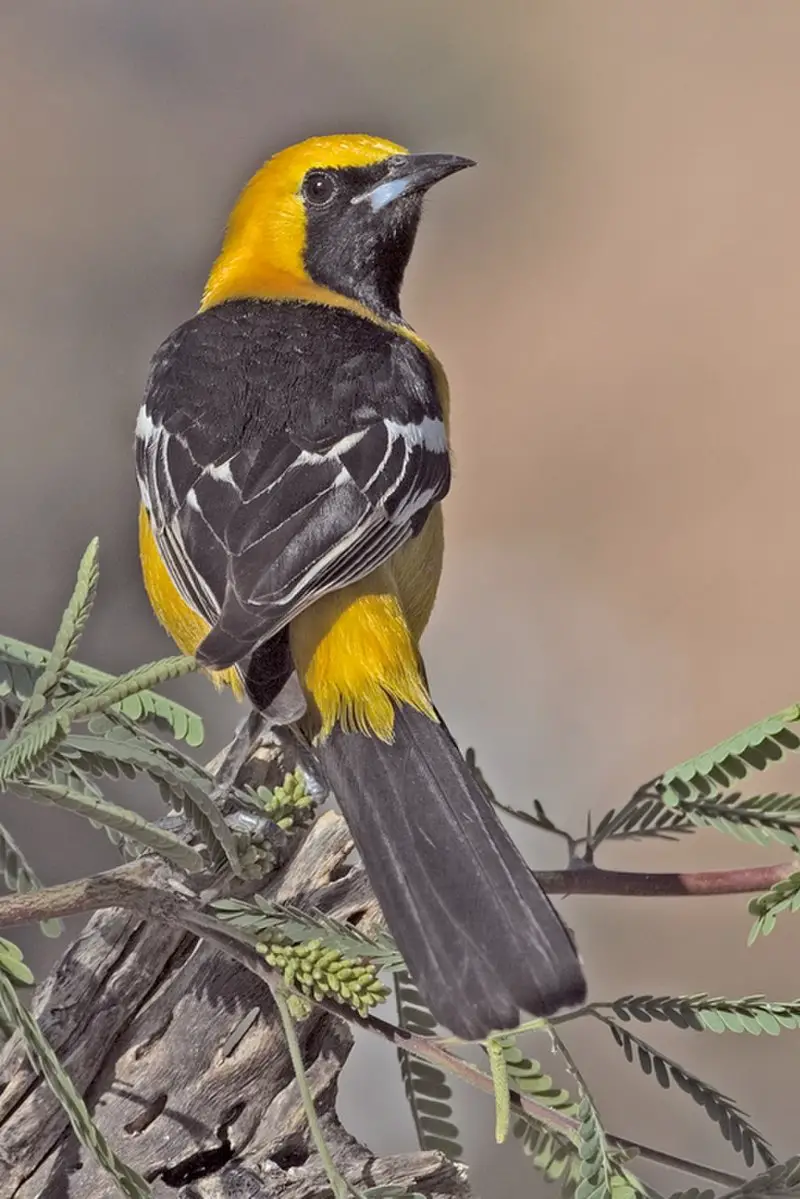
The Hooded Oriole is a medium-sized New World bird with bright, vibrant colours. The male has an orange to yellow body and black back, face, tail and bib.
Its wings have two white bars that stand out against the dark feathers surrounding it. The female is more of an olive colouration but also shows some yellow accents too.
Both sexes have a curved bill which is completely black in colour as well as having white wing bars on its wings for easy identification from other birds in the area.
It typically lives in open woodlands or tropical areas where there are plenty of trees providing food sources such as insects and fruit for them to eat while they perch amongst their branches during nesting season.Scientific classification:
| Kingdom | Animalia |
| Phylum | Chordata |
| Class | Aves |
| Order | Passeriformes |
| Family | Icteridae |
| Genus | Icterus |
| Species | I. cucullatus |
21. Cooper’s Hawk
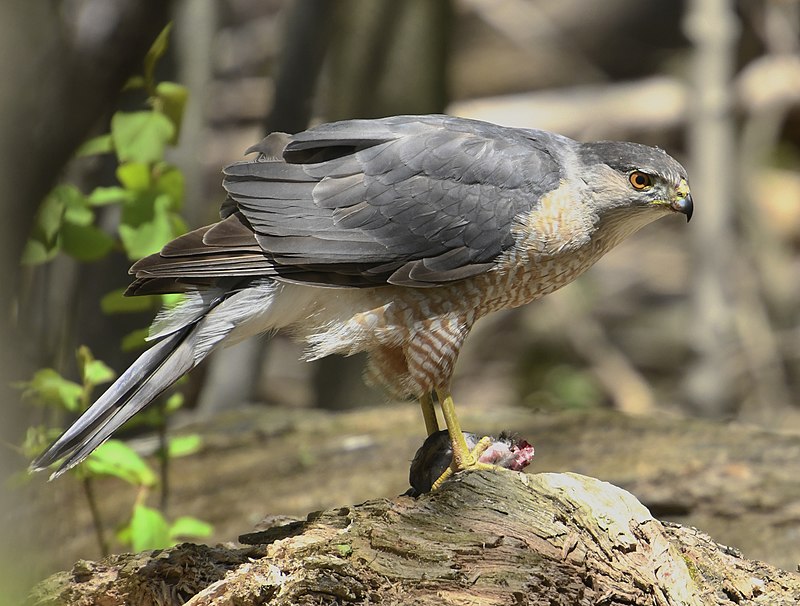
Cooper’s Hawk is a medium-sized bird of prey native to North America. It belongs to the Accipiter genus, which are known for their agility and small size compared to other hawks.
They usually inhabit wooded areas, making them well-adapted hunters in dense environments.
Cooper’s Hawks have rounded wings with short tails that help them maneuver quickly through trees when chasing after prey such as small rodents or birds.
These raptors also possess powerful feet equipped with sharp talons used for catching food items on the ground and even out of midair.
The adult plumage has barred upperparts, ranging from greyish brown on lighter individuals up to dark chestnut colors found in darker specimens; they also display rusty underparts marked by thin white streaking down either side of their chests and bellies.Scientific classification:
| Kingdom | Animalia |
| Phylum | Chordata |
| Class | Aves |
| Order | Accipitriformes |
| Family | Accipitridae |
| Genus | Accipiter |
| Species | A. cooperii |
22. Golden-Crowned Sparrow
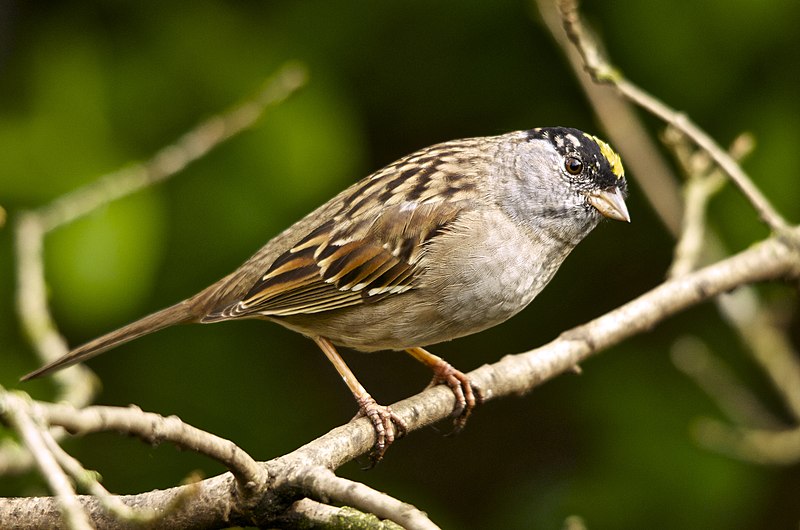
The golden-crowned sparrow is a large New World bird found in the western part of North America. It belongs to the genus Zonotrichia, made up of five species and has no subspecies.
This bird is closely related to the white-crowned sparrow as studies show their mitochondrial DNA evolves at a similar rate.
The most recognizable feature on this beautiful creature are its distinctive yellow stripes near its forehead that appear almost like an orange crown when seen from afar.
Its plumage can range from grey browns in winter months, to dull yellows and oranges during breeding season which typically occurs between April and July.
These birds are often seen foraging through leaf litter or along grassy fields looking for seeds, insects and berries to eat while they sing sweet melodies throughout their habitat.Scientific classification:
| Kingdom | Animalia |
| Phylum | Chordata |
| Class | Aves |
| Order | Passeriformes |
| Family | Passerellidae |
| Genus | Zonotrichia |
| Species | Z. atricapilla |
23. White-Crowned Sparrow
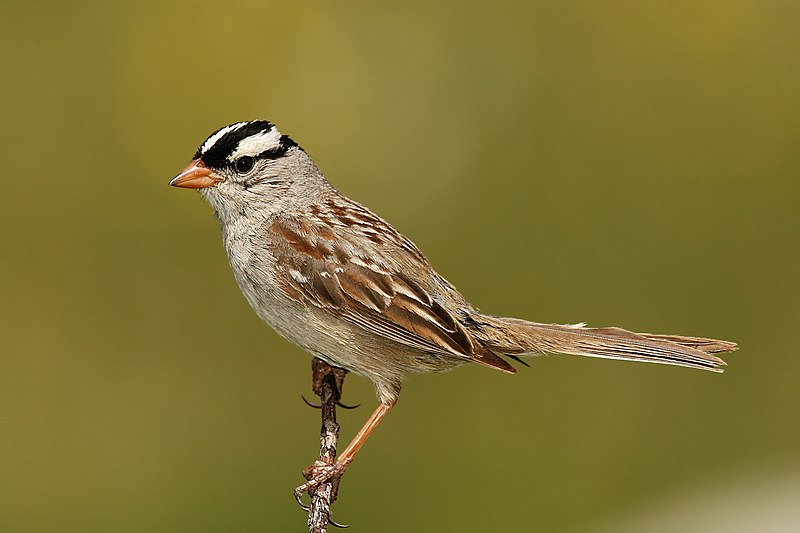
The White-crowned Sparrow is a species of passerine bird native to North America. It has a grey face and black and white streaking on its upper head, making it easy to identify.
This sparrow usually breeds in brushy areas located in the taiga, tundra, Rocky Mountains or Pacific coast regions of North America.
During winter months these birds migrate southward as far as Mexico and California where they can be found living amongst chaparral shrubbery or low bushes near open fields with plenty of seeds nearby.
The diet of this bird consists mainly of insects during summer while they switch over to eating grains like wheat & oats during colder months when bugs are scarce.
They are known for their characteristic chirp which sounds like “Oh sweet Canada Canada” drawing admirers from around the world.Scientific classification:
| Kingdom | Animalia |
| Phylum | Chordata |
| Class | Aves |
| Order | Passeriformes |
| Family | Passerellidae |
| Genus | Zonotrichia |
| Species | Z. leucophrys |
24. American Dusky Flycatcher
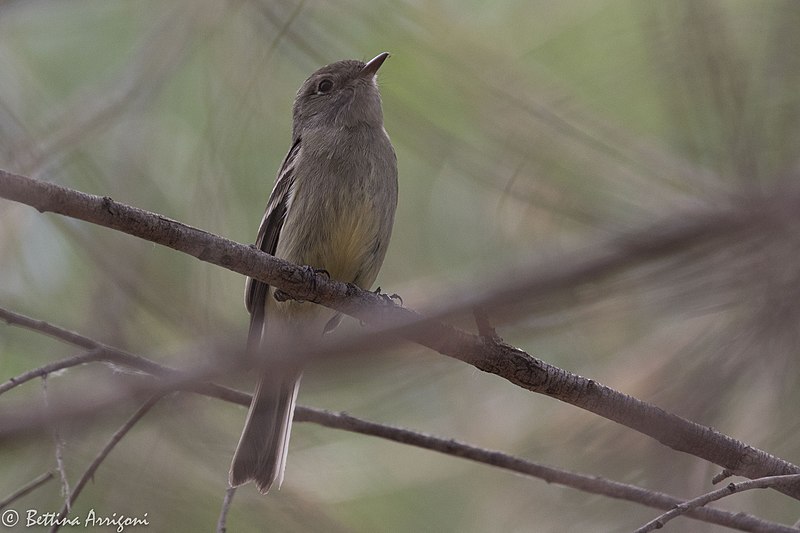
The American dusky flycatcher is a small insectivorous passerine belonging to the tyrant flycatcher family. It is one of many species in the Empidonax genus, which can be difficult to differentiate from each other due to their similar appearance and behavior.
The best way to identify this particular bird is by its unique voice; it has a loud “chick-a-dee” call that sets it apart from any other type of flycatcher.
Its plumage varies slightly depending on location, but typically consists of dark gray or brownish upperparts with whitish underparts and wings marked with white wingbars.
Dusky Flycatchers prefer open woodlands filled with deciduous trees such as willows or cottonwoods for nesting sites, where they feed on flying insects like flies and moths during breeding season.Scientific classification:
| Kingdom | Animalia |
| Phylum | Chordata |
| Class | Aves |
| Order | Passeriformes |
| Family | Tyrannidae |
| Genus | Empidonax |
| Species | E. oberholseri |
25. Nelson’s Sparrow

Nelson’s sparrow is a small New World sparrow named after the American naturalist, Edward William Nelson. It was once considered to be part of a single species known as the sharp-tailed sparrow.
These birds have brownish upperparts with gray on their crowns and wings that are edged in white.
They have buffy underparts which become paler towards their bellies and they feature two prominent stripes along either side of their throats.
Males tend to be darker than females, particularly during breeding season when they can show chestnut patches on their heads and necks as well as black streaks down its flanks.
This bird prefers wet areas for nesting such as marshes, swamps or grasslands near water where it feeds mainly on insects but also consumes seeds from various plants including wild rice grains found in shallow waters nearby its habitats.Scientific classification:
| Kingdom | Animalia |
| Phylum | Chordata |
| Class | Aves |
| Order | Passeriformes |
| Family | Passerellidae |
| Genus | Ammospiza |
| Species | A. nelsoni |
26. Chestnut-Collared Longspur
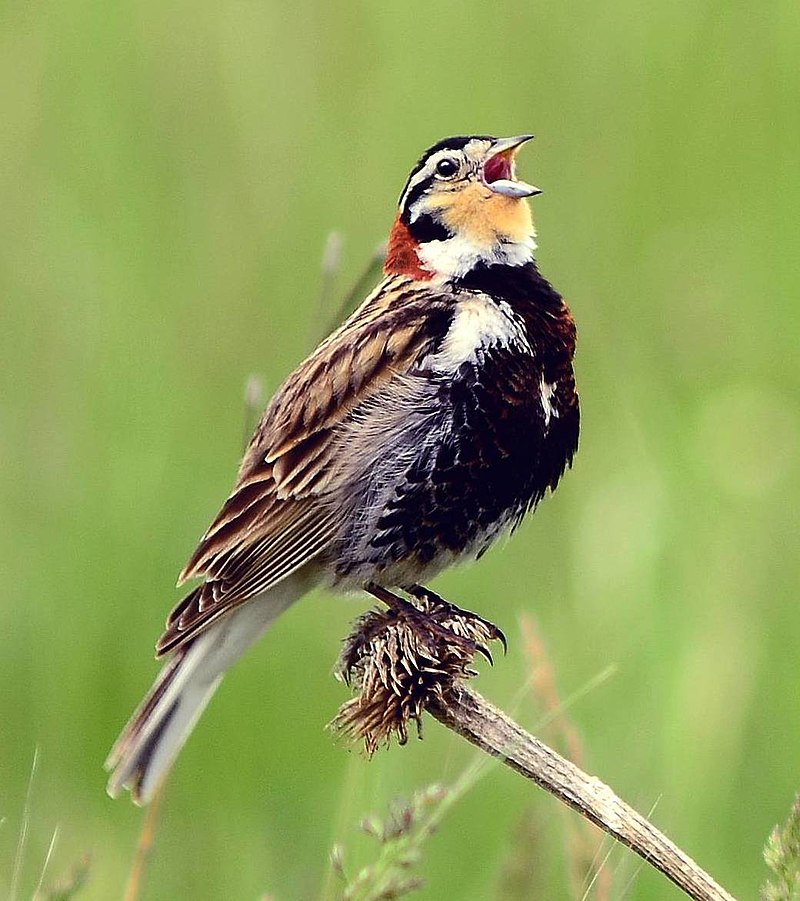
The Chestnut-collared Longspur is a small, seed-eating bird that primarily inhabits prairie habitats in Canada and the northern United States.
It has a short conical bill, a streaked back and white tail with dark markings along its edges.
During the breeding season they move northward to their nesting grounds while during winter they migrate southwards towards Mexico and parts of US where temperatures are more favourable for survival.
They form flocks when migrating or searching for food which can contain up to 50 birds at any given time.
The diet of this species consists mainly of seeds but also includes insects such as grasshoppers, beetles etc., making them an important part of the local ecosystem by controlling insect populations.
These little birds may be hard to spot due to their elusive nature but if you’re lucky enough you might spot one on your next visit outdoors.Scientific classification:
| Kingdom | Animalia |
| Phylum | Chordata |
| Class | Aves |
| Order | Passeriformes |
| Family | Calcariidae |
| Genus | Calcarius |
| Species | C. ornatus |
27. Hermit Warbler
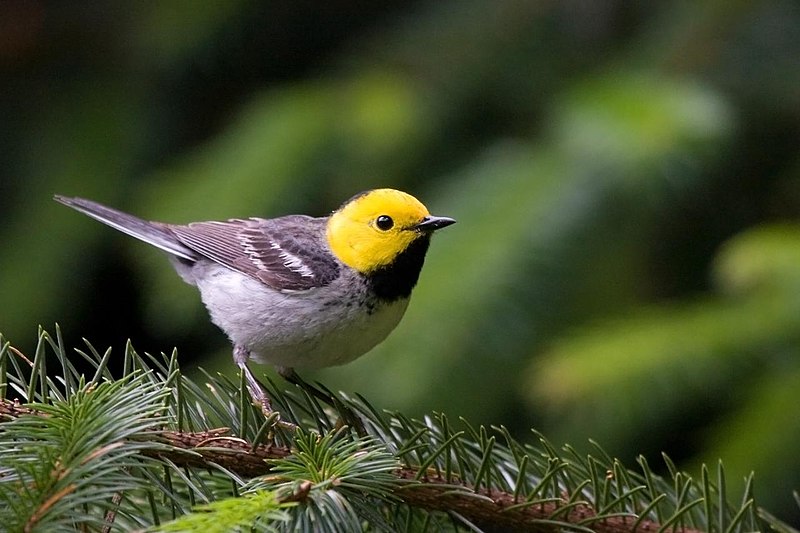
The Hermit Warbler is a small, migratory bird that breeds in the majority of the west coast of the United States. It has dark gray upperparts and light yellow underparts with two white wing-bars on its wings.
Its tail is short and pointed at tip, giving it a unique look among warblers. During wintertime they migrate to Mexico, Central America as well as some parts of southern California for shelter from cold weathers.
They are often seen feeding on insects during their migration or when breeding near wetlands and other moist habitats such as coniferous forests or grasslands by catching them midair with acrobatic agility.
The hermit warbler is an important species for biodiversity conservation since it acts like an ‘indicator’ species – if this particular type of bird population decreases so does the healthy status of our natural environment.Scientific classification:
| Kingdom | Animalia |
| Phylum | Chordata |
| Class | Aves |
| Order | Passeriformes |
| Family | Parulidae |
| Genus | Setophaga |
| Species | S. occidentalis |
28. Black-Chinned Sparrow
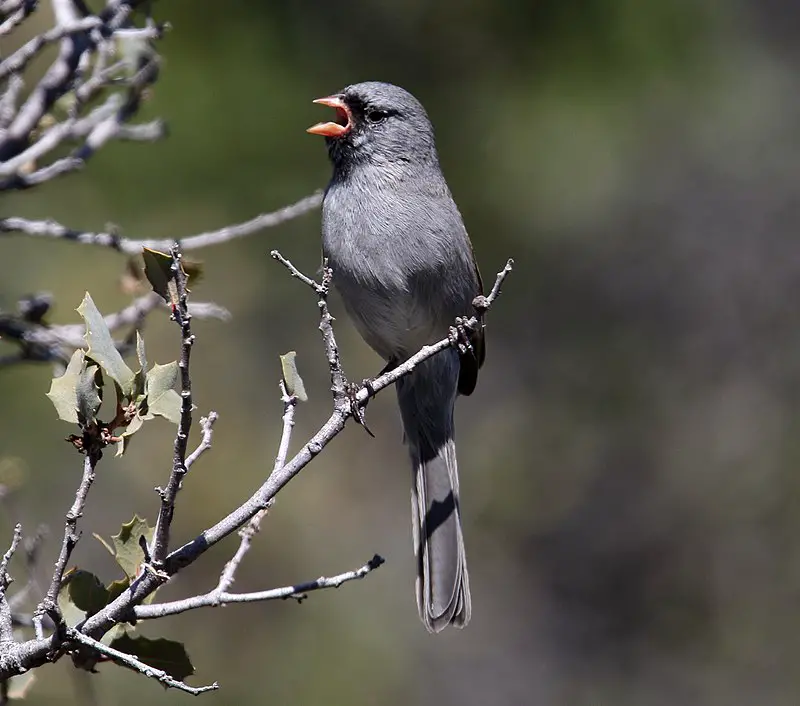
The Black-chinned Sparrow is a small, slim bird found in the southwestern United States and Mexico. It has gray plumage with reddish-brown on its wings, tail feathers, and black chin.
Its long tail helps it to maneuver quickly through dense vegetation when searching for food or seeking shelter from predators.
This species migrates south after breeding during summer months while those living in Mexico are year-round residents of their habitat.
The diet consists mainly of seeds but they will also eat insects such as grasshoppers and caterpillars as well as spiders and other invertebrates for protein rich nutrition supplementing their seed based diet.
They require open habitats like grasslands to find food sources so conservation efforts focus on providing these important habitats throughout their range.
This includes avoiding land conversion into agricultural areas which could impact them adversely if not managed properly by local authorities.Scientific classification:
| Kingdom | Animalia |
| Phylum | Chordata |
| Class | Aves |
| Order | Passeriformes |
| Family | Passerellidae |
| Genus | Spizella |
| Species | S. atrogularis |